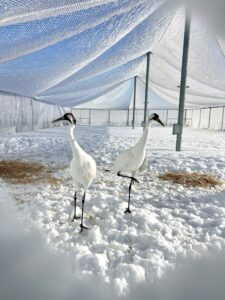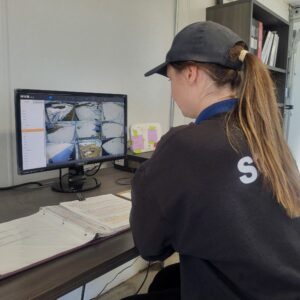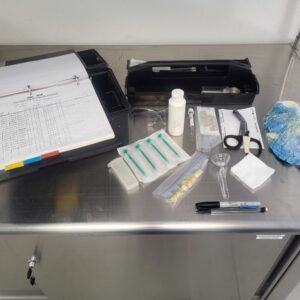Inside the Wilder Institute Whooping Crane Conservation Breeding Program
April 7, 2025

Amid North America’s wetlands, the whooping crane stands as a symbol of resilience. Towering at 1.5 meters with a wingspan stretching over two meters, this striking bird is impossible to miss—its black wingtips tucked beneath brilliant white feathers, a crimson crown adding to its impressive presence. Its name comes from its unmistakable trumpeting call, a sound that was nearly silenced forever. Once on the brink of extinction, the whooping crane’s remarkable comeback is often referred to as a conservation success—a testament to the power of collaboration, science, hope, and your ongoing support.
Once widely found across North America, the whooping crane population was reduced to just 21 birds by the 1940s due to hunting and habitat loss. All of these remaining birds nested in Wood Buffalo National Park. Thanks to dedicated conservation efforts, the species has made a slow but steady recovery. As of 2023, an estimated 698 whooping cranes survive in the wild. However, reintroduced populations are not yet self-sustaining, and growing environmental pressures make it even harder for the species to fully recover. Despite significant progress, there is still more work to be done.
The Wilder Institute has been involved in conservation breeding for whooping cranes since 1992. Chicks hatched at our offsite wildlife conservation centre—the Archibald Biodiversity Centre (ABC)—are either released into reintroduced wild populations or become part of ongoing breeding programs.

‘The Marsh’, home to whooping cranes, at ABC when it was first completed in 2023
A key part of conservation breeding is maintaining genetic diversity. Using genetic analysis and collaborating with partners across North America, we carefully select breeding pairs to ensure the strongest genetic matches for the species’ long-term survival.
It Starts with a Dance
A good genetic match is only the first step—cranes must also be behaviorally compatible. Over time, whooping cranes form strong bonds, reinforced through elaborate courtship dances that involve leaping, wing-flapping, head-tossing, and calling.
Click below to watch a pair of newly introduced Whooping cranes engage in encouraging positive or “affiliative” courtship behaviours. Their interactions signal a promising pair bond, and our team is hopeful for successful mating and chick-rearing.
We currently care for 17 whooping cranes, 14 of which are paired. Many of these pairs have been together for years, like ‘Tim’ and ‘Bombadil’, who have been mates since 2014. Tim (17 years old) and Bombadil (20 years old) are the biological parents of ‘Reed’ and ‘Harp’, who were released into the wild in 2023. While Tim and Bombadil hatched Reed, another bonded pair, ‘Ish’ and ‘Aurora’, hatched and reared Harp as foster parents.

Around mid-March, the Animal Care, Health, and Welfare (ACHW) team at ABC begins observing courtship and bonding behaviors. Remote cameras help monitor breeding activity, egg laying, and signs of incubation.


A Little Help with BreedingSome whooping crane pairs breed naturally, while others need assistance through artificial insemination (AI). The ACHW team identifies which pairs may require help by analyzing video footage of breeding attempts. AI helps to manage genetic diversity, increase fertility rates and allows bonded pairs to stay together, even if they are not genetically ideal matches. It can also support birds with physical limitations, that make natural breeding difficult.
The Arrival of Eggs
By mid-April, our team closely watches for signs of egg laying and incubation. Both male and female whooping cranes take turns sitting on the nest, keeping their olive-colored, brown-speckled eggs warm. The team uses the camera system to confirm egg laying without disturbing the parents.
To encourage additional egg production, the first egg from a breeding pair may be removed and placed under a foster pair that was unable to produce eggs. This approach maximizes reproduction and enhances the chances of successful rearing.
Throughout the 29–31-day incubation period, our team closely monitors the cranes and their eggs remotely. Around nine or ten days after an egg is laid, we use a bright light to check for signs of a developing embryo—this is called candling. If the egg is fertile, it goes back under the cranes for incubation and if it isn’t fertile, we will replace it with a replica aka ’dummy’ egg, for the pair to carry out their incubation behaviors. While we prioritize parent-rearing, we also have incubators ready if needed.


Whooping crane egg candling showing a fertile egg. Artificial aka ‘dummy eggs’ used in the whooping crane breeding program.
Hatching and Early Care
Hatching is a demanding process that can take up to 72 hours. The chick pecks persistently at their shell, eventually breaking free into the world. Unlike their striking white parents, newborn chicks are covered in soft, rusty-orange feathers that they will gradually shed over the next few months.
Once hatched, the chicks receive expert care at our breeding facility, including daily welfare checks, veterinary exams, and a specialized crane diet. Their future will be determined later—some will be released into the wild, while others will remain at the facility as part of the breeding program.
Click below to watch a whooping crane chick undergoing its initial veterinary exam, carefully conducted by the Animal Care, Health & Welfare team.
A Future of Hope
We are committed to supporting the recovery of the whooping crane by increasing successful breeding efforts and advancing long-term recovery strategies, while working closely with partners on translocations and efforts to safeguard habitats.
Together, and with your support, we can help this iconic species thrive once more, securing its place in the biodiverse landscapes we cherish for generations to come.
